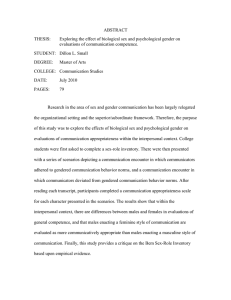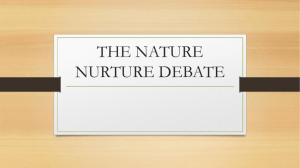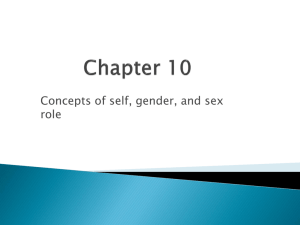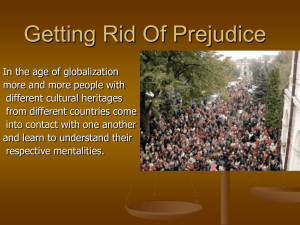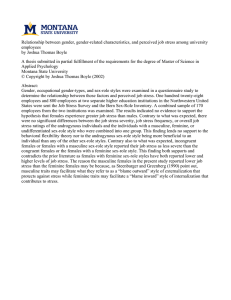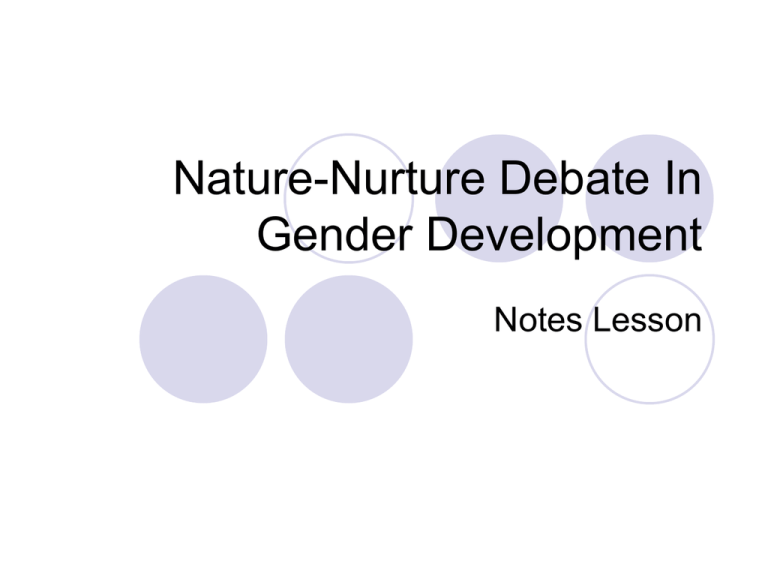
Nature-Nurture Debate In
Gender Development
Notes Lesson
The Nature Argument
The nature debate states that gender is
biological. This explains the strong
relationship between a person’s sex and
gender.
Evolutionary mechanisms such as
procreation are instinctive, this could mean
that gender is innate as well.
Cross-cultural Research Studies
Buss (1994) –
Heterosexual
preferences in males
and females.
Mead (1935) –
Cultural variations in
gender role.
(Berdache)
Challenging Western Assumptions of
Gender Role.
Best et al (1994) – Challenges ‘Males and
females are naturally different in their
parenting roles.’
Pontius (1997) – Challenges ‘Males have
innately superior spatial skills.’
Roscoe(1998) – Challenges ‘There are
only two genders.’
Sugihara and Katsurada (1999) – ‘Males
are born masculine and females are born
feminine.’
The Nurture Argument
Gender is a essentially a product of
socialisation. Therefore, family upbringing
and societal expectation must play a role.
It explains why some people adopt the
opposite gender role to their sex.
It also explains cultural variations in
gender roles. People will rely on cultural
beliefs, values and norms.
Sex-Role Stereotyping
Beliefs, values and norms
are transmitted by agents
of socialisation, such as
parents, peers the
education system and the
media. These groups
work collectively to
reinforce certain
behaviours and
discourage others.
Sex-Role Stereotyping
Sex-role stereotyping
leads to a situation
where individuals are
expected to behave in
certain ways
associated with their
sex. E.g. Females are
the main carer and
Males are the main
bread winner.
Research studies for
Sex-Role Stereotypes (Content Analysis)
Kortenhaus and
Demarest (1993) –
Teenage magazines.
Peirce (1993) – TV
Adverts.
Furnaham and
Farragher (2000) –
Sex-Role Stereotypes
in British TV Adverts.
Example - Heineken
http://www.youtube.com/watch?v=jfZ0UCVxGI
Furnaham and Farragher (2000) – SexRole Stereotypes in British TV Adverts
Samples of TV adverts were taken over a
month. 200 were analysed according to
the central figure of the advert.
Men were presented in autonomous roles
(for example, as professionals, celebrities)
whereas women were most likely to be
presented in familial roles (for example as
home-makers).
Fagot (1978) – Investigating Parental role
and the effect on gender.
Parents acted in a
more positive way
when a child was
engaged in genderappropriate behaviour
and in a more
negative way in the
opposing instance.
Gender: Nature or Nurture
Diamond and
Sigmundson (1997)
Review of the Bruce –
Brenda Case study first
conducted by Dr John
Money.
This is clear evidence of
nature outweighing the
attempts to nurture this
male child into a feminine
role.
http://www.youtube.com/
watch?v=3GhbVFjIaN0&f
eature=results_main&pla
ynext=1&list=PLE415288
3C485B6B3
Interactionist Approach
Many psychologists
nowadays adopt an
interactionist
approach to
explaining gender,
and recognise that
gender is a product of
both biology and
environmental
experiences.
Key Terms
Innate
Cross-cultural
research
Universal
Gender role
Ethnographic
Western Society
Socialisation
Norms
Agents of
Socialisation
Sex-Role
Stereotyping
Sex-Role Stereotypes
Interactionist
Approach

